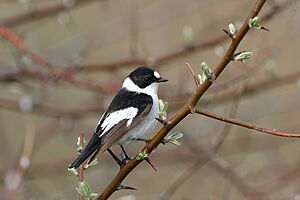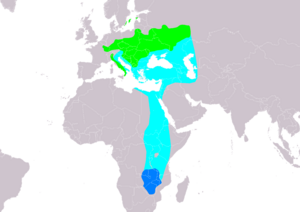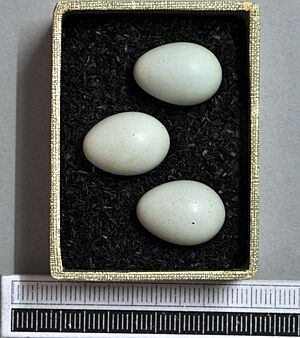Collared flycatcher facts for kids
Quick facts for kids Collared flycatcher |
|
|---|---|
 |
|
| Adult male | |
| Conservation status | |
| Scientific classification | |
| Genus: |
Ficedula
|
| Species: |
albicollis
|
 |
|
| Range of F. albicollis Breeding Passage Non-breeding | |
The collared flycatcher (Ficedula albicollis) is a small songbird. It belongs to a group of birds called Old World flycatchers. These birds are known for catching insects in the air.
Collared flycatchers breed in parts of southeast Europe, including islands in the Baltic Sea. They also live from Eastern France to the Balkan Peninsula and Ukraine. When winter comes, these birds fly long distances to warmer places. They spend their winters in sub-Saharan Africa. Sometimes, they are seen in western Europe, but this is rare.
Contents
What Does a Collared Flycatcher Look Like?
Collared flycatchers are small birds, about 12 to 13.5 centimeters (around 5 inches) long.
Male Collared Flycatchers
When it's breeding season, the male collared flycatcher is easy to spot.
- It has a mostly black back and white belly.
- A clear white collar around its neck.
- A large white patch on its wings.
- A black tail, though some males have white on the sides of their tail.
- A big white patch on its forehead.
- A light-colored rump (the area above its tail).
- Its beak is black and shaped like a wide, pointed cone. This shape helps it catch insects while flying.
Female and Young Collared Flycatchers
Female collared flycatchers and young birds look a bit different.
- Instead of black, their feathers are a pale brown color.
- They can be tricky to tell apart from other similar flycatchers.
- Two birds that look very much like the collared flycatcher are the European pied flycatcher and the semicollared flycatcher.
Where Do Collared Flycatchers Live?
These birds love to live in forests with deciduous trees. These are trees that lose their leaves in the fall, like oak trees. You can also find them in parks and gardens. They especially like places with old trees that have holes or cavities.
Nesting and Eggs
Collared flycatchers build their nests inside these tree holes. They also use special nest-boxes that people put up for them.
- Their nests are open, cup-shaped structures.
- A female usually lays about 5 to 7 eggs.
What Do Collared Flycatchers Eat?
Collared flycatchers are mainly insect eaters.
- They are very good at catching insects while flying through the air.
- They also hunt for caterpillars among the leaves of oak trees.
- Sometimes, they will eat berries too.
The Collared Flycatcher's Song
The song of the collared flycatcher is a series of slow, drawn-out whistles. It sounds quite different from the song of the European pied flycatcher. Interestingly, pied flycatchers sometimes copy the song of the collared flycatcher when they live in the same areas.
Why Are Collared Flycatchers Important to Science?
Scientists study collared flycatchers a lot.
- They help us understand how animals live in their environment (ecology).
- They also help us learn about how traits are passed down through generations (genetics).
- The collared flycatcher was one of the first birds to have its entire genome mapped. This means scientists have a complete map of all its genetic information.
- Scientists have learned that it's rare for these birds to breed with close relatives. When it does happen, it can cause problems for the young birds.



